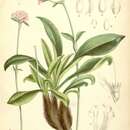en
names in breadcrumbs


Nardostachys jatamansi is a flowering plant of the valerian family that grows in the Himalayas. It is a source of a type of intensely aromatic amber-colored essential oil, spikenard. The oil has, since ancient times, been used as a perfume, as a traditional medicine, and in religious ceremonies. It is also called spikenard, nard, nardin, or muskroot. It is considered endangered due to overharvesting for folk medicine, overgrazing, loss of habitats, and forest degradation.
Nardostachys jatamansi is a flowering plant of the honeysuckle family that grows in the eastern Himalayas, primarily in a belt through Kumaon, Nepal, Sikkim and Bhutan.[3] The plant grows 10–50 cm (4–20 in) in height and has pink, bell-shaped flowers.[4] It is found at an altitude of 3,000–5,000 m (9,800–16,400 ft). Rhizomes (underground stems) can be crushed and distilled into an intensely aromatic amber-colored essential oil, which is very thick in consistency. Nard oil is used as a perfume, an incense, a sedative, and an herbal medicine said to fight insomnia, birth difficulties, and other minor ailments.[5]
Preliminary research on the chemical components of Nardostachys jatamansi indicates the plant contains:[6]
Nardostachys jatamansi may have been used as an ingredient in the incense known as spikenard, although lavender has also been suggested as a candidate for the spikenard of classical times.[7]
Nardostachys jatamansi is a flowering plant of the valerian family that grows in the Himalayas. It is a source of a type of intensely aromatic amber-colored essential oil, spikenard. The oil has, since ancient times, been used as a perfume, as a traditional medicine, and in religious ceremonies. It is also called spikenard, nard, nardin, or muskroot. It is considered endangered due to overharvesting for folk medicine, overgrazing, loss of habitats, and forest degradation.